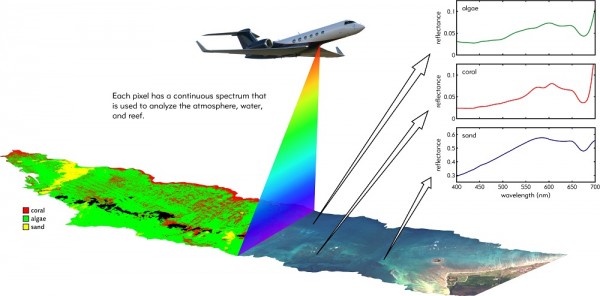NASA to Monitor Coral Reefs Around the World from 23,000 Feet Above
| Ana Verayo | | Jun 13, 2016 04:56 AM EDT |
(Photo : NASA JPL CORAL) NASA JPL's CORAL campaign will be able to monitor and collect data from coral reefs at 23,000 feet.
NASA and scientists around the world join together to save the world's coral reefs, as NASA launched late last week a new initiative to collect data from coral reefs located from 23,000 feet above the surface of the planet.
Like Us on Facebook
NASA's Jet Propulsion Laboratory will lead this campaign for three years, which is known as the Coral Reef Airborne Laboratory (CORAL) as scientists and researchers will use this program to determine the environmental forces that are affecting coral reefs around the world.
According to CORAL principal investigator, Eric Hochberg, this mission will be carried out as an airborne monitoring program to survey reefs located in the Pacific where its main goal is to gain new perspective from a larger scale and identify the current conditions of the reefs, which can greatly help scientists in conducting research.
According to biology professor Julia Baum from the University of Victoria, divers are often limited by depth of the waters while diving and since there is so much science to be uncovered from great ocean depths, studying coral reefs can be challenging and can take a very long process.
To date, coral bleaching among the Great Barrier Reef is so extensive that human divers are very limited to explore them. This area is so expansive that it would be as long as British Columbia in Canada to Baja, California and Mexico.
Hochberg who is also from the Bermuda Institute of Ocean Sciences says NASA's CORAL will also be able to produce the most extensive images to date of the major portion of the world's coral reefs derived from a standard data set.
Using a Portable Remote Imaging Spectrometer (PRISM) aboard an airplane, CORAL will collect data from specific areas and places to further confirm observations. These areas will include key coral reefs in the Mariana Islands, Hawaii, the Great Barrier Reef and Palau.
PRISM will collect data via three different types of measurements, coral calcification, primary productivity and the amount of sand, coral and algae in any given area where these numbers will be used as a basis for future research.
This new dataset will reveal trends among biogeophysical forces that are both natural and manmade, to show the coral reefs' conditions. More importantly, this will help scientists to create better predictions of the global coral reef ecosystem and also provide crucial data for governments to provide necessary protection and conservation efforts.
TagsNASA, NASA CORAL campaign, coral reefs, Coral bleaching, Great Barrier Reef, save the coral reefs
©2015 Chinatopix All rights reserved. Do not reproduce without permission
EDITOR'S PICKS
-

Did the Trump administration just announce plans for a trade war with ‘hostile’ China and Russia?
-

US Senate passes Taiwan travel bill slammed by China
-

As Yan Sihong’s family grieves, here are other Chinese students who went missing abroad. Some have never been found
-

Beijing blasts Western critics who ‘smear China’ with the term sharp power
-

China Envoy Seeks to Defuse Tensions With U.S. as a Trade War Brews
-

Singapore's Deputy PM Provides Bitcoin Vote of Confidence Amid China's Blanket Bans
-

China warns investors over risks in overseas virtual currency trading
-

Chinese government most trustworthy: survey
-

Kashima Antlers On Course For Back-To-Back Titles
MOST POPULAR
LATEST NEWS
Zhou Yongkang: China's Former Security Chief Sentenced to Life in Prison

China's former Chief of the Ministry of Public Security, Zhou Yongkang, has been given a life sentence after he was found guilty of abusing his office, bribery and deliberately ... Full Article
TRENDING STORY

China Pork Prices Expected to Stabilize As The Supplies Recover

Elephone P9000 Smartphone is now on Sale on Amazon India

There's a Big Chance Cliffhangers Won't Still Be Resolved When Grey's Anatomy Season 13 Returns

Supreme Court Ruled on Samsung vs Apple Dispute for Patent Infringement

Microsoft Surface Pro 5 Rumors and Release Date: What is the Latest?










